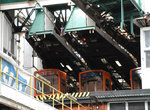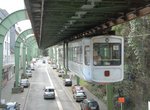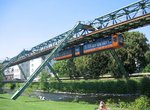Wuppertal, Germany

Figure 3. The Langen Suspended Railway over the River Wupper.
The Langen Suspended Railway (Wuppertaler Schwebebahn)
Engineering News · Vol. 43, No. 13, Jan.-Jun. 1900, page 218.
The days when inventors of freak railway systems could get the ear of capitalists seem to have passed in the United States, or at least there has been a lull in their activity since the days of Capt. Meigs, with his famous Boston Rapid Transit scheme, and of E. Moody Boynton, with his bicycle railway. On the other side of the water, however, inventors of this class still flourish apparently, and we illustrate in the accompanying cut one of the most remarkable railway systems that ever reached the stage of actual construction. It is the invention of Herr Eugene Langen, of Cologne, and the line now being built extends through the towns of Barmen, Elberfeld and Vohwinkel, Germany. A section long enough to allow of tests has been completed and is illustrated in the accompanying cuts, and it is stated that the whole road, some 8.25 miles long, will probably be completed this year. Our contemporary, the "Zeitschrift des Vereines Deutscher Ingenieure," from whose pages the accompanying illustrations are reproduced, has published a description of this system taken from a pamphlet issued by the builders of the present road, the Kontlnentalen Gesellschaft für elektrische Unternehmungen of Nuremberg. The following is translated from the above-named article:
"The first experiments with Herr Langen's hanging railway were made with a two-rail system, and an experimental line was built at Cologne. This was an elliptical track, 328 ft. in length, with two sharp curves of 33 ft. radius. Upon this a speed of 7.5 miles per hour could be attained. A second track was then built of the same dimensions, but with only a single rail. The cars were suspended by two trucks and were free to swing sidewise. On this a speed of 15.5 miles per hour was reached; and at this speed the cars swung outwards on the curves with an inclination of 25 degrees from the vertical. The passengers, however, had no disagreeable sensations, and the tests were considered a success. It was therefore proposed by the owners of the Langen patents to erect a suspended railway for the cities of Barmen, Elberfeld and Vohwinkel, where an ordinary elevated road was being planned by the municipalities, and the proposal was accepted. Originally it was still intended to erect a two-rail construction, but, the substantial advantages of the mono-rail system having become apparent, the latter was chosen.
"The road will be 8.25 miles long, and is double-track for the entire distance. Part of the way the line runs over the bed of a small stream, the Wupper, and part of the way through the city streets. Upon the main line the sharpest curves are 295 ft. radius and upon the sidings, of 19 ft. radius. The steepest grade is 4.5%. It is never necessary to slacken speed because of the grades or curves of the main line.
"The supporting structure, as well as the cars and their mode of suspension, is shown in Fig. 3 and details are illustrated in Figs. 1 and 2. Over the Wupper the roadway is carried by inclined posts, as shown in Fig. 3, and in the city streets by curved posts. The posts are left free to move in the direction of the road, which allows for expansion and contraction of the supported spans due to temperature changes. In order to render the structure stable, rigid towers are placed at intervals of 200 or 300 yds., and the track is left free to expand in either direction from these.

Figure 1. Side elevations and cross sections of the Langen Suspended Railway.
"The car hangs from two trucks placed 26.25 ft. apart. Each truck is provided with two wheels carrying between them an electric motor designed to deliver 36 HP. at 500 volts. The arrangement and mode of suspension of the trucks are well shown in Fig. 2. The truck-frame "r" surrounds the sleeper "t" quite closely in order that the wheels may not jump the rail, and that the car may not be precipitated to the ground as the result of the failure of some detail of the truck. The current is taken from a contact-rail by a slip-shoe. The speed is controlled, as in street-railway practice, by series-parallel arrangements of the motors and resistance. Braking is provided for by Westinghouse air-brakes, hand-brakes and devices to short-circuit or reverse the motors. A maximum speed of 25 miles per hour is expected. The cars will carry 50 persons and it is expected that trains of one or two cars will be operated, although the stations will admit four-car trains. The cars may be reached by elevated stations, which, however, are much lower than is usually necessary with elevated roads.

Figure 2. Detail of truck for the Langen Suspended Railway.
"The span of the supports, partly because of the unsatisfactory nature of the foundations along the Wupper and partly to avoid obstructing the street traffic, is made very great, in some places nearly 98 ft. However, the total weight of supports and track on the line over the Wupper is only 766 lbs. per ft., and in the streets only 715 lbs. per ft. The total cost of the structure, inclusive of foundations and stations, is from $172,000 to $192,000 per mile."
We fail to find in our contemporary's description any statement of advantages, real or imaginary, to be gained by this peculiar form of construction over the ordinary railway systems in common use. We should imagine that the swinging of the car in pendulum fashion, as it rolls along, might be so considerable as to make riding in it very uncomfortable for persons with a tendency to sea-sickness. At high speeds this swinging might even become so great as to cause derailment, and it would at least complicate the problems of rail wear and rail support in a most troublesome manner. Other objections to the system are so obvious that we need not point them out; and we give space for its illustration here only as a curious monstrosity in engineering, which is not likely to be anywhere repeated.
Since the above was in type we have received from Mr. O. Petri, General Manager of the company above named, a large pamphlet fully describing the system, which he informs us has been patented in all civilized countries, the patents being controlled by his company. The advantages here claimed for the system are, that sharp curves can be traversed at high speed and with perfect safety, and that an elevated railway on this system offers the minimum of obstruction to light and air. An exhibition line on this system will be shown at the Paris Exposition.
Photo Gallery
| Five Random Images | ||||
 Image 63245 (198k, 1044x706) Photo by: Richard Panse Location: Kluse |  Image 63560 (219k, 864x574) Photo by: Peter Ehrlich Location: Vohwinkel Depot |  Image 63562 (188k, 864x574) Photo by: Peter Ehrlich Location: Vohwinkel |  Image 65983 (175k, 1044x706) Photo by: Richard Panse Location: Sonnborner Str. |  Image 98087 (179k, 1024x768) Photo by: Jos Straathof Location: Oberbarmen Depot |
Photos By Location
Photo locations: Vohwinkel Depot, Vohwinkel, Kaiserstrasse & Bahnstrasse, Bruch, Hammerstein, Sonnborner Str., Sonnborner Str. & Kornstrasse, Zoo/Stadion, Varresbeck, Passing Bayer Factory, Westende, Pestalozzi Str., Robert Daum Pl., Ohligsmühle, Wuppertal Hauptbahnhof/Döppersberg, Kluse, Landgericht, Völklinger Str., Loher Brücke, Adler Brücke, Alter Markt, Werther Brücke, Wupperfeld, Oberbarmen, Oberbarmen Depot, (Misc/Unknown)
Page Credits
Text from Engineering News, Vol 43., No. 14, Jan-Jun 1900, page 218.